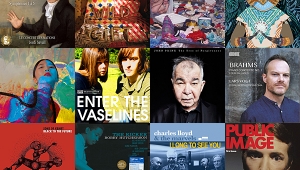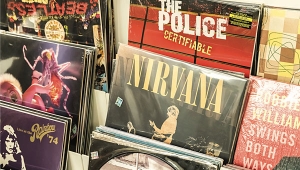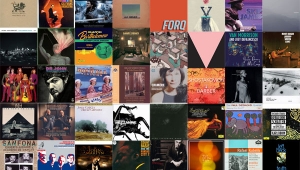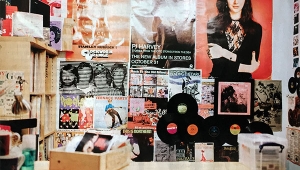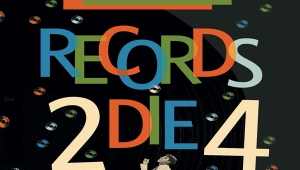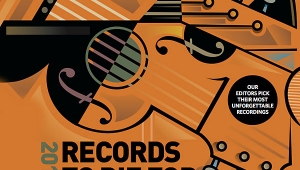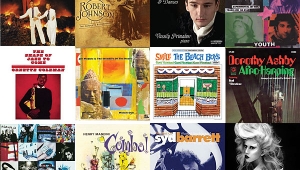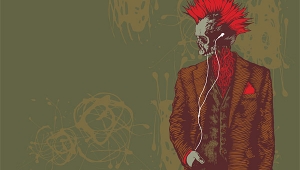| Columns Retired Columns & Blogs |
2001 Records to Die For Page 8
David Sokol
KIM RICHEY: Bitter Sweet
Mercury 314-534 255-2 (CD). 1997. Angelo, prod. ("I Know" prod. by John Leventhal); Peter Coleman, eng., mix. AAD? TT: 48:40
Kim Richey is best known as a singer's songwriter—her songs have been covered by Trisha Yearwood, Patty Loveless, Terri Clark, and other Music City hotshots. But she's a natural in the studio, and Bitter Sweet is the best of her three smart and excellent albums. Richey conveys hurt, heartache, and everyday conflict as well as anyone, and there isn't a more honest and convincing singer in country music. On top of that, the production here is so organic and natural—healthy dollops of mandolin, pedal steel, banjo, even accordion fill out the full band sound—that it sounds as if she's right there in your living room. Americana at its bitter-sweetest.
PROCOL HARUM: Home
A&M SP 4261 (LP). 1970. Chris Thomas, prod.; Jeff Jarratt, eng. AAA. TT: 39:02
Procol Harum will forever be remembered for "A Whiter Shade of Pale," its cryptic, dual-keyboard smash from the Summer of Love. But it is the band's fourth LP, released three years later, that stands not only as Procol's masterpiece but also as the definitive progressive-rock album. Preoccupied with nightmares, graveyards, and death (quite appropriate for an R2D4, no?), Keith Reid's lyrics are surreal and gothic, though often overshadowed by Gary Brooker's and Robin Trower's disarmingly cheery or churchy melodies. In addition to the eerie songs—in "The Dead Man's Dream," for instance, the singer relates a most delirious and spooky deathbed vision, only to wake up and die—there's also a classic slice of down-and-dirty rock ("Whiskey Train"), and some of the most tasteful and inventive rock drumming of all time, courtesy the late B.J. Wilson. (Home is available as part of the band's three-disc 30th Anniversary Anthology, released in 1997 on Westside, and as a single disc with nine bonus tracks, released on Westside in 1999.)
WAGNER: Götterdämmerung
Astrid Varnay, Brünnhilde; Bernd Aldenhoff, Siegfried; Hermann Uhde, Gunther; Elisabeth Höngen, Waltraute; Heinrich Pflanzl, Alberich; Ludwig Weber, Hagen; Martha Mödl, Gutrune, Third Norn; Elisabeth Schwarzkopf, Woglinde; Hanna Ludwig, Wellgunde; Hertha Töpper, Flosshilde; Ruth Siewert, First Norn; Ira Malaniuk, Second Norn; Wilhelm Pitz, Chorus Master; 1951 Bayreuth Festival Chorus & Orchestra, Hans Knappertsbusch
Testament SBT 4175 (4 mono CDs), Decca/Testament/Speaker's Corner SBTLP 6175 (6 mono LPs). 1999. John Culshaw, prod.; Kenneth Wilkinson, balance eng.; Paul Bally, digital remastering. ADD/AAA. TT: 4:40:22
Recorded by Decca in 1951 for possible release, this tape lay unreleased for decades. Now, it's one of the greatest Wagner performances ever recorded. Conductor Knappertsbusch is supremely inspired: His trademark emphatic rhythms, which so easily can drag, give a monumental grandeur to the music at every turn. And has there ever been more luxurious casting? Has there ever been such a vocally effortless Siegfried? Has his funeral march ever been so steeped in tragedy? Have these roles ever been more effectively acted? Answer to all of the above: I think not. (XXIII-1)
WALTER GIESEKING: From the collection of Deutsches Rundfunkarchiv
Music & Arts CD-1070 (4 mono CDs). 2000. Maggie Payne, technical reconstruction; prods., engs. unknown. ADD. TT: 4:52:55
These four discs are jam-packed with previously unpublished performances by one of the century's greatest pianists during his best years; ie, before 1950. Gieseking recordings—whether live, radio broadcasts, or studio—can be technically rough and emotionally absent, though that's rarely the case here. Schumann's Symphonic Etudes has demonic tempos, Bach's Partitas have a nuance rare for Gieseking in this repertoire, and the selections by Debussy and Ravel have a magical sense of coloring that show why this pianist long reigned supreme in this repertoire. Sound quality is clear and clean but limited, the piano is occasionally out of tune, and movements of pieces are sometimes missing. Yet the sound is more flavorful than many of Gieseking's later, close-miked EMI studio recordings. And, of course, the artistry is astonishing.
DON CHERRY: Complete Communion
Don Cherry, trumpet; Leandro "Gato" Barbieri, tenor sax; Henry Grimes, bass; Eddie Blackwell, drums
Blue Note 5 22673 2 (CD). Alfred Lion, prod.; Rudy Van Gelder, eng. AAD. TT: 40:17
This is Don Cherry's absolute masterpiece. Recording-wise, it's a good example of mid-'60s Rudy Van Gelder—drums hard right, bass center—but this most recent high-resolution, 20-bit master reveals even more air and space and inner detail than it did on Mosaic's superb The Complete Blue Note Recordings of Don Cherry. There's better separation of bass and drums, and that's critical to understanding this music's ebb and flow. In the pianoless tradition of the Gerry Mulligan-Chet Baker and Ornette Coleman-Don Cherry quartets (and the Sonny Rollins trios), the high-wire interplay between Blackwell and Grimes grounds this music in a jaunty New Orleans strut. Yet as hard as they swing, there's an airborne giddiness to their groove that conveys the possibility of imminent danger as everyone goes for broke and breaks on through to the other side, yet comes back home in a heartbeat. Jazz!
RALPH TOWNER/GARY PEACOCK: A Closer View
Ralph Towner, classical & 12-string guitars; Gary Peacock, bass
ECM 1602 (CD). 1998. Manfred Eicher, prod.; Jan Erik Kongshaug, eng. DDD. TT: 54:36
This is the numero uno reference disc in my stash. Over the last few years I've probably spent more time in Towner's aural menagerie than anywhere else in my capacious collection of desert-island discs. Hopefully, that symbolic getaway is stocked with a nice $15,000 system, but this disc is one of a handful that sound good on anything yet are very revealing of high-resolution gear. As much as I cherish analog, this is a digital recording that reveals digital's true potential when it's handled with care and taste by people with golden ears.
CHARLIE SHOEMAKE TRIO: Uncrowned Kings & Long Lost Things
Charlie Shoemake, vibes; Bruce Forman, guitar; Luther Hughes, Fred Atwood, bass; Paul Kreibich, drums
CMG CMD 8054 (CD). 1998. Charlie Shoemake, prod.; Steve Crimmel, eng. DDD. TT: 58:51
Charlie Shoemake's "Uncrowned Kings" are folks like tenorman Hank Mobley and trumpeter Kenny Dorham, giants to their peers but mid-level to the general public. His "Long Lost Things" are tunes that have been forgotten or are simply obscure but deserve another airing. A bebop-bent vibes master and an uncrowned king himself, Shoemake showcases his heroes via their tunes. We get Mobley's jaunty "Avila and Tequila" and Dorham's mad-rushing "Minor's Holiday" alongside the easy flow of Sonny Clark's "Royal Flush." Among the long-lost numbers are "Struttin' with Some Barbeque," "The Heather on the Hill," and "Just a Gigolo." Charlie Parker's "Constellation" is a nod to Shoemake's Number One guy, Bird. The vibist wails a sweet song, pulling neatly crafted lines out of a seemingly inexhaustible imagination on "Holiday," "Royal," and the rest. The equally fluent Bruce Forman on guitar is a like-minded colleague; he brings "Signal," to name just one, fully to life. Luther Hughes and Paul Kreibich are a killer rhythm duo, and Fred Atwood is no slouch on bass. Paring the band down to three pieces allows so much air; this music has remarkably transparent sound.
SONNY CLARK: My Conception
Sonny Clark, piano; Hank Mobley, Clifford Jordan, tenor sax; Donald Byrd, trumpet; Kenny Burrell, guitar; Paul Chambers, bass; Art Blakey, Pete La Roca, drums
Blue Note 5 22674 2 (CD). 1959. Alfred Lion, prod.; Michael Cuscuna, reissue prod.; Rudy Van Gelder, eng. AAD. TT: 61:23
How did this one slip through the cracks? Blue Note's Alfred Lion never released any of this world-class music while he owned Blue Note (he sold the label to Liberty in the 1970s). We can only wonder why.
KIM RICHEY: Bitter Sweet
Mercury 314-534 255-2 (CD). 1997. Angelo, prod. ("I Know" prod. by John Leventhal); Peter Coleman, eng., mix. AAD? TT: 48:40
Kim Richey is best known as a singer's songwriter—her songs have been covered by Trisha Yearwood, Patty Loveless, Terri Clark, and other Music City hotshots. But she's a natural in the studio, and Bitter Sweet is the best of her three smart and excellent albums. Richey conveys hurt, heartache, and everyday conflict as well as anyone, and there isn't a more honest and convincing singer in country music. On top of that, the production here is so organic and natural—healthy dollops of mandolin, pedal steel, banjo, even accordion fill out the full band sound—that it sounds as if she's right there in your living room. Americana at its bitter-sweetest.
PROCOL HARUM: Home
A&M SP 4261 (LP). 1970. Chris Thomas, prod.; Jeff Jarratt, eng. AAA. TT: 39:02
Procol Harum will forever be remembered for "A Whiter Shade of Pale," its cryptic, dual-keyboard smash from the Summer of Love. But it is the band's fourth LP, released three years later, that stands not only as Procol's masterpiece but also as the definitive progressive-rock album. Preoccupied with nightmares, graveyards, and death (quite appropriate for an R2D4, no?), Keith Reid's lyrics are surreal and gothic, though often overshadowed by Gary Brooker's and Robin Trower's disarmingly cheery or churchy melodies. In addition to the eerie songs—in "The Dead Man's Dream," for instance, the singer relates a most delirious and spooky deathbed vision, only to wake up and die—there's also a classic slice of down-and-dirty rock ("Whiskey Train"), and some of the most tasteful and inventive rock drumming of all time, courtesy the late B.J. Wilson. (Home is available as part of the band's three-disc 30th Anniversary Anthology, released in 1997 on Westside, and as a single disc with nine bonus tracks, released on Westside in 1999.)
![]()
David Patrick Stearns
WAGNER: Götterdämmerung
Astrid Varnay, Brünnhilde; Bernd Aldenhoff, Siegfried; Hermann Uhde, Gunther; Elisabeth Höngen, Waltraute; Heinrich Pflanzl, Alberich; Ludwig Weber, Hagen; Martha Mödl, Gutrune, Third Norn; Elisabeth Schwarzkopf, Woglinde; Hanna Ludwig, Wellgunde; Hertha Töpper, Flosshilde; Ruth Siewert, First Norn; Ira Malaniuk, Second Norn; Wilhelm Pitz, Chorus Master; 1951 Bayreuth Festival Chorus & Orchestra, Hans Knappertsbusch
Testament SBT 4175 (4 mono CDs), Decca/Testament/Speaker's Corner SBTLP 6175 (6 mono LPs). 1999. John Culshaw, prod.; Kenneth Wilkinson, balance eng.; Paul Bally, digital remastering. ADD/AAA. TT: 4:40:22
Recorded by Decca in 1951 for possible release, this tape lay unreleased for decades. Now, it's one of the greatest Wagner performances ever recorded. Conductor Knappertsbusch is supremely inspired: His trademark emphatic rhythms, which so easily can drag, give a monumental grandeur to the music at every turn. And has there ever been more luxurious casting? Has there ever been such a vocally effortless Siegfried? Has his funeral march ever been so steeped in tragedy? Have these roles ever been more effectively acted? Answer to all of the above: I think not. (XXIII-1)
WALTER GIESEKING: From the collection of Deutsches Rundfunkarchiv
Music & Arts CD-1070 (4 mono CDs). 2000. Maggie Payne, technical reconstruction; prods., engs. unknown. ADD. TT: 4:52:55
These four discs are jam-packed with previously unpublished performances by one of the century's greatest pianists during his best years; ie, before 1950. Gieseking recordings—whether live, radio broadcasts, or studio—can be technically rough and emotionally absent, though that's rarely the case here. Schumann's Symphonic Etudes has demonic tempos, Bach's Partitas have a nuance rare for Gieseking in this repertoire, and the selections by Debussy and Ravel have a magical sense of coloring that show why this pianist long reigned supreme in this repertoire. Sound quality is clear and clean but limited, the piano is occasionally out of tune, and movements of pieces are sometimes missing. Yet the sound is more flavorful than many of Gieseking's later, close-miked EMI studio recordings. And, of course, the artistry is astonishing.
![]()
Chip Stern
DON CHERRY: Complete Communion
Don Cherry, trumpet; Leandro "Gato" Barbieri, tenor sax; Henry Grimes, bass; Eddie Blackwell, drums
Blue Note 5 22673 2 (CD). Alfred Lion, prod.; Rudy Van Gelder, eng. AAD. TT: 40:17
This is Don Cherry's absolute masterpiece. Recording-wise, it's a good example of mid-'60s Rudy Van Gelder—drums hard right, bass center—but this most recent high-resolution, 20-bit master reveals even more air and space and inner detail than it did on Mosaic's superb The Complete Blue Note Recordings of Don Cherry. There's better separation of bass and drums, and that's critical to understanding this music's ebb and flow. In the pianoless tradition of the Gerry Mulligan-Chet Baker and Ornette Coleman-Don Cherry quartets (and the Sonny Rollins trios), the high-wire interplay between Blackwell and Grimes grounds this music in a jaunty New Orleans strut. Yet as hard as they swing, there's an airborne giddiness to their groove that conveys the possibility of imminent danger as everyone goes for broke and breaks on through to the other side, yet comes back home in a heartbeat. Jazz!
You're already hip to Blackwell's legendary sense of structure, but Grimes may be the greatest bass player you never heard. His vibrant percussive attack suggests the coiled tension of an archer's bow strung with 200-lb gut string, pulled taut and fully extended before being released with a resounding twang that resonates in the belly of the bass and permeates your very being. Even if you can't hear it, you can feel it. Each note has that sense of authority behind it, and Grimes' intonation is so dead-on that even his most abstract syncopations and modulations convey a sense of harmonic focus and intention.
Cherry exploits their power for all it's worth with some of the most poignant, joyous, swinging writing in the history of jazz. "Complete Communion" and "Elephantasy" are lovingly structured extended forms—four-part suites composed of lovely out-of-time arias, punctuated by infectious dancing vamps and some of the most thrilling improvised releases in the history of jazz, in which Barbieri's fearless, unhinged chants are the perfect counterpoint to Cherry's gorgeous, expansive phrasing. I return again and again to the title tune and "Our Feelings," in which Cherry picks up the baton from Gato over a 440-relay tempo as Grimes' stop-and-go, half-note/eighth-note release supercharges the trumpeter as he accelerates into the bell lap, alternating between chant and blues, skittering dissonances, and ripe, limber melodic refrains that are heroic in scope and execution. (XXIII-6)
RALPH TOWNER/GARY PEACOCK: A Closer View
Ralph Towner, classical & 12-string guitars; Gary Peacock, bass
ECM 1602 (CD). 1998. Manfred Eicher, prod.; Jan Erik Kongshaug, eng. DDD. TT: 54:36
This is the numero uno reference disc in my stash. Over the last few years I've probably spent more time in Towner's aural menagerie than anywhere else in my capacious collection of desert-island discs. Hopefully, that symbolic getaway is stocked with a nice $15,000 system, but this disc is one of a handful that sound good on anything yet are very revealing of high-resolution gear. As much as I cherish analog, this is a digital recording that reveals digital's true potential when it's handled with care and taste by people with golden ears.
Recorded by auteur Manfred Eicher and his finest cinematographer, Jan Erik Kongshaug (at their favorite recording venue, Rainbow Studio in Oslo, Norway), A Closer View has an extraordinary sense of space, depth, and dimensionality. The sound is intimate and sublimely detailed, yet remarkably visceral and immediate in its impact. The leading edge of Peacock's bass on "Opalesque" is so resoundingly round and quick, so incredibly detailed and clearly delineated in space, that it serves to focus the spacious, expansive web of Towner's chords as they toll away in the tranquil, alluring ambience of an incredibly deep, resonant soundstage. This is chamber jazz of the highest order, and Towner and Peacock's technical mastery serves naught but the music. Their sumptuous tones draw you deeper into the interplay: on an abstract sonic sculpture such as "Infrared," Towner's 12-string glows like an off-minor quasar, and their acoustic transients are rendered with near-symphonic intensity. And on "Beppo" (a beige cousin to boppo), they achieve a sense of give-and-take and joyous propulsion worthy of Bill Evans and Scott LaFaro or Miles Davis and Tony Williams. Ralph Towner is nonpareil: he has carved out a niche for himself on acoustic guitar unlike anyone else in all of jazz.
![]()
Zan Stewart
CHARLIE SHOEMAKE TRIO: Uncrowned Kings & Long Lost Things
Charlie Shoemake, vibes; Bruce Forman, guitar; Luther Hughes, Fred Atwood, bass; Paul Kreibich, drums
CMG CMD 8054 (CD). 1998. Charlie Shoemake, prod.; Steve Crimmel, eng. DDD. TT: 58:51
Charlie Shoemake's "Uncrowned Kings" are folks like tenorman Hank Mobley and trumpeter Kenny Dorham, giants to their peers but mid-level to the general public. His "Long Lost Things" are tunes that have been forgotten or are simply obscure but deserve another airing. A bebop-bent vibes master and an uncrowned king himself, Shoemake showcases his heroes via their tunes. We get Mobley's jaunty "Avila and Tequila" and Dorham's mad-rushing "Minor's Holiday" alongside the easy flow of Sonny Clark's "Royal Flush." Among the long-lost numbers are "Struttin' with Some Barbeque," "The Heather on the Hill," and "Just a Gigolo." Charlie Parker's "Constellation" is a nod to Shoemake's Number One guy, Bird. The vibist wails a sweet song, pulling neatly crafted lines out of a seemingly inexhaustible imagination on "Holiday," "Royal," and the rest. The equally fluent Bruce Forman on guitar is a like-minded colleague; he brings "Signal," to name just one, fully to life. Luther Hughes and Paul Kreibich are a killer rhythm duo, and Fred Atwood is no slouch on bass. Paring the band down to three pieces allows so much air; this music has remarkably transparent sound.
SONNY CLARK: My Conception
Sonny Clark, piano; Hank Mobley, Clifford Jordan, tenor sax; Donald Byrd, trumpet; Kenny Burrell, guitar; Paul Chambers, bass; Art Blakey, Pete La Roca, drums
Blue Note 5 22674 2 (CD). 1959. Alfred Lion, prod.; Michael Cuscuna, reissue prod.; Rudy Van Gelder, eng. AAD. TT: 61:23
How did this one slip through the cracks? Blue Note's Alfred Lion never released any of this world-class music while he owned Blue Note (he sold the label to Liberty in the 1970s). We can only wonder why.
Some tunes have an in-your-face charge, like the leadoff, "Junka," in which Art Blakey gleefully chomps down on his sock cymbal and the horns of Mobley and Byrd unfurl a series of melodically resplendent tones. Others, such as the back-beaten "Blues Blue" or the intense but not incendiary "Royal Flush," allow for a more mellow approach, though the music is still plenty potent. Clark plays with such telling smoothness, speaking his thoughts in complete sentences, his ideas all coming to fruition. On three tracks, Cliff Jordan and Kenny Burrell spell Mobley and Byrd, and Pete LaRoca is in for Blakey. "Eastern Incident," with its slight Asian cast, and the dapper "Minor Meeting," are ear-grabbers. A way-big soundstage and crisp details are additional pluses of this prime example of '50s hard bop—as good as it gets. (XXIII-6)
- Log in or register to post comments

